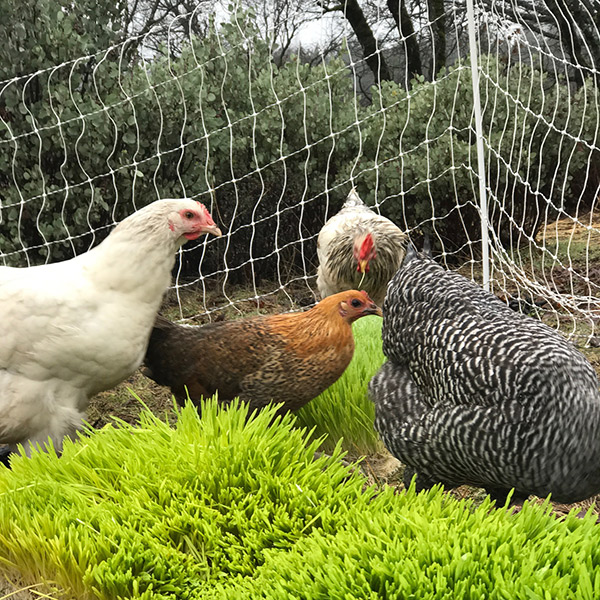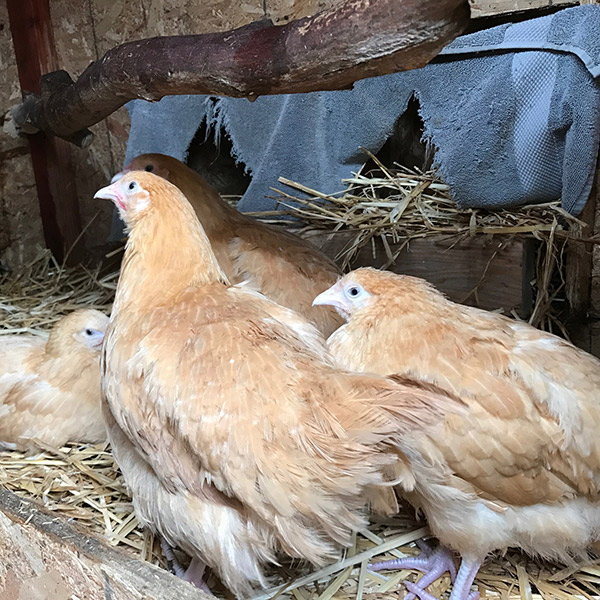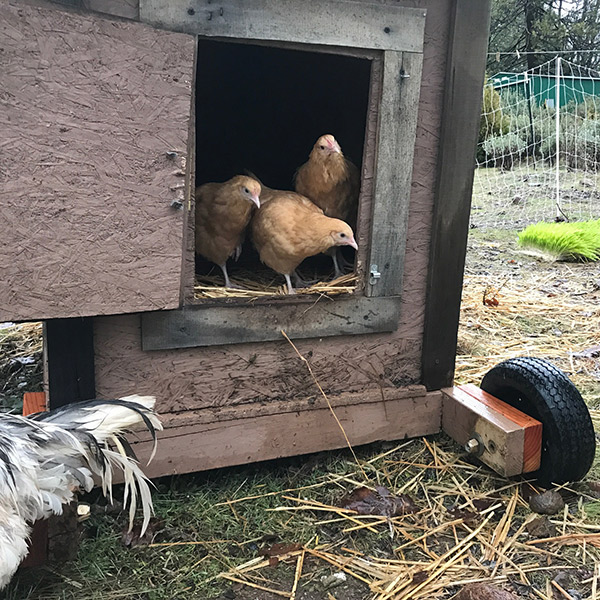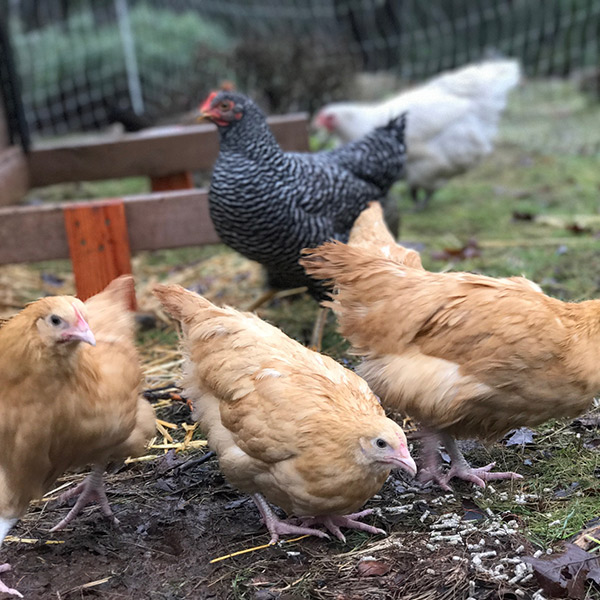Have you ever lost a new chicken, within hours of bringing it home? Or spent the night searching with a spotlight for a pullet that didn’t come home to roost? Or most commonly, seen that one poor new chicken take the brunt of all the harassment?
I have a solution for you. Plus a FREE eBook at the end of this post.
I’ve experienced all of these, what follows is a process for introducing new chickens or pullets into an existing flock without these issues.
For clarity, I am using new chicken and pullet interchangeably, as the difficulties of introducing either into an existing flock is the same.
Why does this matter?
First, chickens need to establish a pecking order, this social order is how they function. They are not a democratic species and they are not interested ensuring everyone has equal shares of food, water and a place to roost. Rather chickens have evolved to use an authoritarian style system, where the pecking order establishes who does what first. It is literally just that, pecking to establish order, where the most aggressive chicken submits the others becoming the top chicken.
When chickens are born and raised together this pecking order establishment is not as apparent. But as chicken farmers we sometimes need to introduce new birds into existing flocks and the fight for dominance can sometimes lead to lost feathers, blood or even death.
We don’t want to remove the establishment of the pecking order we want to create conditions where the flock is as calm as possible upon introduction to keep the blood and death to a minimum.
Second, newly introduced chickens do not have a home yet. The coop is the territory of the existing flock. When new chickens are introduced into a flock and they have no home and they are getting bullied it is understandable that they would want to fly away and establish their own home and flock.
When chicken farmers are using open top run setups, like the electric poultry netting, we can reduce the impulse for birds to fly off and leave by easing this transition.
Introducing new chickens to a flock
Over the past few years, I organized a method for introducing new birds to an existing flock that is easy on you and the chickens.
This method is what I have distilled down from various introduction attempts into a streamlined process.
For example, some people like to slowly introduce the birds by keeping them in separate runs or paddocks, allowing the new and old chickens to hear and see each other but not physically meet.
I have taken this step and altered it to place the new birds into the coop during this initial meeting period. This allows the new and old birds to see and hear (depending on your coop design) each other PLUS the new birds get an opportunity to become familiar with the coop as their home.
This is the permaculture aspect of introducing chickens – we are stacking functions. Steps are combined to be as time efficient as possible as most farmers or homesteaders have much time to spare.
Time of day and exactly where you place the new birds upon introduction are the two keys to this approach.
Currently, it’s January and the days are short, so you may want to shift times accordingly for the overall goal. The end goal is to have about 1-2 hours of co-mingling before they roost for the night and several hours of alone time in their new coop on the first day.
First Day
Original Flock: Kick Them Out of the Coop (12pm)

Lock the original flock out of their coop and keep them out ranging for the afternoon.
Do this once your original flock has finished laying their eggs for the day. Otherwise they will get upset and try to get back into the coop.
Give them supplemental feed or kitchen scraps now to keep them occupied and make sure they won’t be hungry when they get introduced later. I have found that chickens that are full tend to go easier on newly introduced birds.
New Birds: Introduce to their New Coop (12:15pm)

Introduce the new pullets and shut them inside.
Be sure all of the original flock is out ranging and only the new birds are shut in the coop.
I keep the electric fence on while I am brining the new birds into the run and placing them in the coop. This is in case the new pullet gets out of my hands and gets free – if the fence is not on they tend to try to run through it and might be difficult to recover depending on your landscape.
TIP: Be sure food and water is in the coop at this time. Also, if it is mid summer, be sure the coop is not too hot for the birds.
The pullets will get to spend the afternoon settling into the coop and getting familiar with it. The time in the coop is important as it allows the birds to get familiar with this new safe place.
With the original flock ranging and the pullets in the coop, they will be able to start hearing (and maybe seeing) one another, which is starting the process of getting familiar with each other.
New Birds: Release from their new coop (4pm)

It is time to let the new birds out to explore the run and meet the existing flock.
This seemingly inconsequential event has a big part of this process. The new pullets get to experience for themselves exiting the coop. They now know it is available to them. Often, they will slowly explore coming out, taking their time and going back and forth between in and out as they determine if it is safe to come out.
This is by far the best part. I love their cautious yet curious nature – you can see they by default want to be cautious and slowly make their way out of the coop but at the same time their child like curiosity pushes them beyond their cautiousness.
It is at this point where I pull up a 5 gallon bucket, flip it upside down, and take a seat. I like to watch them to see how the birds are interacting.
Let them establish a pecking order, but if any one bird is being a bit too rough or any one pullet is getting pecked at too much, toss some grains into the run. This usually redirects their focus.
Even with clipped wings they can fly enough to get over the short 48″ electronet fencing. SoI tend to keep feeding during this hour or two of initial introduction, to keep the original chickens pre-occupied. It is important when adding food to spread it all around the run and not concentrating in one area so they can’t become territorial over the food. The birds need to eat and not be concerned that the new pullet next to them is eating their food.
Everyone: Chicken Bedtime (5pm)

After about an hour of interaction time the sun should be setting and the original flock will retire to their coop for the night to roost.
The new pullets most likely won’t follow the older birds into the coop the first night. They might try to all nest under something. It is as this point that I know they are ready for bed and I pick them and place them into the coop and shut the door for the night.
Typically, by the second or third night the new chickens choose to roost for the night in the coop with the rest of the flock, especially if the flock integration went smoothly.
Second Day
The second day get up near sunrise to open the coop as early as possible.
The less space chickens have the more violent they become while establishing a pecking order. This is why it is important on the first morning to open the coop up early.
When walking toward the run listen to the birds before opening to assess if there are any issues going on – such as birds being rough on the new pullets while confined to the coop.
The whole second day I tend to check on the birds every hour or so; mostly just to ensure the new pullets haven’t escaped.
In my most recent introduction of 4 pullets, twice all 4 escaped without me seeing how, but they were easily caught and placed back into the run with the other ladies.
In Sum
What I have observed is that the timing and order of events in this approach to introducing new poultry to a flock tends to:
1) Reduce the more extreme flogging by older hens
2) Give the new pullets a sense of the coop as their home quickly
What I have experienced with this approach is a near seamless introduction of new member to a flock.
- Step 1 (12 pm) – Shut your flock out of the coop
- Step 2 (12:15 pm) – Place pullets in coop and shut door
- Step 3 (3-4 pm) – Open coop let pullets out to meet flock
- Step 5 (5pm) – Shut up coop for night, placing pullets inside if necessary

FREE MINI EBOOK
25 Questions to ask When Selecting Your Ideal Chicken Breed For Your Permaculture Homestead or Farm
We respect your privacy and never give out emails or spam you. Just good ‘ol permaculture content will grace your inbox.









I inherited 5 – 6 month old hens (3 black Australops and 2 white leghorns) to add to my original 5 RIR’s that are 5 months. Right now they’ve been separated for 1 day but can see each other and at first there was some scuffles through the bars. The RIR’s have had the coop and free ranging, the newbies have the run. Should I put the newbies in the coop this afternoon and lock my girls out? The is kind of stressful because I want it to be successful and I’m also worried it might be a little crowded.
{HHA Coach} Nope. Definitely don’t do that. Just put the hens all together after everyone goes to bed and then let them out together before sunlight when they wake up. If scuffles continue, keep separate during the day. Crowding is a definite issue & can cause long term issues. A good rule of thumb is that each chicken needs 3 square feet inside the coop and 10 square feet in the run if they aren’t able to free range.
I have 3 17 week old pullets. All three are different breeds (1 EE, 1 Gold sex Link, 1 Barred Rock). We had a rooster with them up until about 3 weeks ago. They still seem to be reestablishing a pecking order and nine of them have started laying. We would like to add a 13 week old pullet. Would this method work for us?
Just to clarify in my first comment, it should say none of them have started laying. Thanks!
{HHA Coach} Yes! Take it slow and easy when introducing a single chicken to an established flock, but they usually get their ducks in a row pretty quickly. 😉
I have 7-4 month old chickens, 2 roosters (1 to be re-homed this week) and 5 hens. I took an older hen who has been in the coop already. Tried to introduce her and did not go well. 2 nd rooster really went after her. Didn’t have the guts to put her in the coop last night. Now I am getting 3 hens that are 4 months old this weekend. Question, is should I have the 4 in the coop together and introduce them all together This is now her territory so I think she will go after the new hens. Wish I hadn’t taken her. Didn’t do my research and I’m paying for it now! I have a chicken tractor that has a run and a fenced area around that. I’d say they have about. A300 ft at area. Any suggestions would be greatly appreciated!
(HHA Coach) I would remove the aggressive rooster asap. Don’t tolerate that in the coop! There is also not enough space + hens for both roosters to have enough resources to behave.
You can create an agreeable space for all the hens + one rooster. If I were in your shoes, I’d put the four NEW hens in a smaller space next to the run so they original flock can all see & hear one another. Do this during the day and place them in the coop at night. It should only take a few days for everyone to start getting along.
Also, as a side note – if anyone has any open wounds from the fighting, they need to be separated until it heals. Chickens are ruthless little beasts and will prey upon the smell/sight of blood.
Let me know how it goes!
Thanks so much for your help, Jesscy. Since then things have changed. I found a home for the second rooster. He will be going when I get the new hens. I will do exactly as you suggest and will let you know how it goes!
Jesscy, everything is going great! The new hens ended up hanging out (hiding) in the coop for most of today. The older gals were being pretty good with them except for a peck here and there. The rooster is already taking great care of them. I had to leave for a while tonight. When I came home all of the hens were up on the high roost together! I am so happy it’s working. I thought it would take sooo much longer to get to this point. Thank you so much for your help!
{HHA Coach} YAY, Lisa! I’m so happy for your little flock. Great work, Chicken Mama! <3
Thanks for this information. I am introducing 3 older chickens(all ready egg laying) and my flock of 10 are only 14 weeks old and still on starter/growing feed. I have no way to separate food in my coop, which food should I offer the entire flock for the 4 weeks until my chickens switch to pellets? Or should just put both options out?
{HHA Coach} Offer a non-medicated chick starter in addition to the regular feed you offer your flock. Don’t make a medicated feed available to all your birds.
Would you recommend this method for a flock of 6 4 and a rooster, about to welcome 2 new girls? Does a roo make a difference?
{HHA Coach} Hey Amy! Are you referring to the introduction method or the feeding method that I answered the previous question on? Sorry for the confusion, I just want to make sure I’m answering correctly.
If you’re asking whether or not the advice this lesson provides is a good way to intro your two new ladies into the flock, then yes! This is a great resource. It sounds like you just have one rooster? If so then don’t change a thing. If there’s 2 roos with that few hens, you’re going to run into some issues.
A rooster will calm everyone down and make the transition easier??
{HHA Coach} Hey Eric! Not necessarily. Roosters can cause issues depending on many factors such as size of flock, whether they’re free range & the breed of rooster to name a few.
I’d love recommendations for introducing 6 pullets into existing 3 hens. My 3 originals are strictly free range and are shut in a coop at night. There is no outside pen
{HHA Coach} Hi Susan! Great question. I’m not sure how large your coop is, but the best way to go about this safely is to find a way to keep the 3 new hens in the coop for no less than 2-3 full days/nights. This way everyone has a chance to get used to one another & the new ladies will be familiar with where they return to roost at night. If this isn’t possible, creating a make shift pen outside but near the coop for outside day time & then placing them manually in the coop after the original crew has had a chance to roost for the night is another good option.
Thanks a bunch. Coop is plenty big. Will give leaving them all in for 2-3 days a try.
We got 3 chickens back in April. Unfortunately, one chicken was taken by a predator out of the coop about a month ago. The 2 remaining have finally seemed to feel secure again and we were wanting to get another chicken around the same age / size to replace the one we lost.
Would this advice be the same while only introducing 1 new chicken, or would this be a mistake?
{HHA Coach} Hi Tammy!
Introducing a single bird to a flock can be tricky. I can be done, but everything takes a little longer & the new bird can be singled out for life depending on your other hens.
My advice would be to get 2-3 new birds if you have the space and go through the new intro steps so that they can more easily integrate.
I really only have space for about 3 chickens. I would just stick with the 2, but Henrietta (who hadn’t really been laying consistently yet) hasn’t laid since Gerry was killed and I’m worried she won’t. The whole reason I got them was for egg production for the family. But, of course, we love Henrietta so she’s family now.
I’ll have to think about what I should do. Thanks!
{HHA Coach} If you only have room for 3 then just go slow and be consistent about the intro. It can work! Henrietta will lay. Stress can cause a disruption in their laying cycle, but it always starts again. 🙂
Great advice! We have 7 eight week olds and are thinking of adopting another 3 (out of a flock of 12) from someone who has just found it to be too much work with their current situation. Do we need to quarantine the 3 new ones before introducing them?
{HHA Coach} I would quarantine. It’s always the wise choice. Chances are there’s nothing to worry about, and many people choose not to. But in the case that there is, you could potentially introduce disease to your whole flock. NOT something you want! Speaking from experience. 😉
How would you do introductions with one group of 6 week olds and one group of 4 week olds all getting ready for a new coop and run? They have been side by side in a large brooder with hardwire cloth between the two groups for about 3 weeks now while we finish the new run and coop. Everything is ready and none of the birds have been in the new coop or run yet. Should we put them all in the run for introduction time before the going to bed in the coop, or should we place them all in the coop and let them all find there way to the run? Any advice would be greatly appreciated.
{HHA Coach} Hi, Maria! I’d stick them all in after dark together and get up early to open the coop in the am. They’ll find their way out to the run in the am & will be best buds! You may have a squabble or two, but it’ll be easy with chicks that age that have been near to one another for 3 weeks. 🙂
Great! Thanks so much for the advice.
Hi, we don’t have a flock, just one older hen. We have one pallet who should be ready to introduce in two weeks. Do I modify the above at all, given that there’s only 2 birds?
Thanks
{HHA Coach} Hey there, Gail! Everything can stay the same. You still want to make sure the birds are friendly with one another & familiar with their surroundings before introducing them to one another. So fun now that they both have a friend!
Hi Jesscy, thanks for the reply. Yes my older girl, Hobbes, has outlived 5 “sisters”, and I feel like she must be lonely. I’m looking forward to her having a new friend.
Super helpful! So permaculture, thanks
Excellent!! Just did it introducing two juvenile roosters to two older roosters in bachelor pen. The dominant rooster immediately took over their care and protected them from other rooster. What a surprise. Although I have quite often been surprised by chicken compassion. Thank you again
I introduced three Java hens to my dwindling back yard flock. We were down to two barred rocks. We have a hen house that is eight by ten. during the day the chickens roam our large back yard. I clipped the wings of the Javas and turned them loose in the yard in the late afternoon. I caught them after the barred rocks went nite nite inside their house. They have a good roost but have taken to sleeping on top of their nest boxes. This is probably due to a predator, probably a skunk or coon murdering a couple of their sisters before the hen house door was closed. I put the Javas in with the Barred Rocks. The next day the Javas went right into the hen house when the sun went down. The next morning they were huddled in a corner. After a few days they were all huddled on top of the nest box together. The early morning temp was 19 degrees. I thought, great. When I open the door in the morning the barred rocks leave first and go to their feed. During the day I noticed that the Javas pretty much keep to themselves.
We are going on vacation for a week and the person who takes care of our chickens leaves for work before it is light. The last time we lost 2 hens to the predator. Our hen house has an over hang roof that is about 5 feet wide and ten feet long. I poured a slab on the floor, put plywood four feet high around three sides and a door in the front. I am going to chicken wire the top so that it is enclosed. It’s not that big but I thought including the hen house, 15x 10 feet should be plenty for 5 chickens while we are gone. So the first morning I shut them in I was somewhat distressed to find out that the Javas are terrified of the barred rocks and for good reason. I couldn’t help but notice the gentle eye that the javas have while the Rocks have a glint in their eye like Jack the Ripper. The Javas came out as usual this morning but I left the door closed so that they could all get used to being together. It wasn’t long before the Javas were back on top of the nest box. it’s kind of weird that the Rocks are so dominating since they are smaller. Every time the the Javas come down from on top of the nest box the Rocks go after them. I guess putting them in close quarters was like starting all over again. I let them out after a few hours. I will repeat this process for a few days. Interesting side note. The chickens left their lay mash to peck through the shavings on the hen house floor. We have had some warm days. I’m thinking there is fly larvae mixed in with the shavings.
I had a group of older chickens and tried to put new ones in (they were all about same size by then) but the old ones pushed all the new ones into a corner and the 12 new ones all laid on top of each other and would not move from corner like they were afraid to. In the morning a few of the new ones who were on bottom of the corner had been smoothered to death. even though the coop was 40 ft by 20 ft and had 2 diff wooden inside areas and 2 sets of food and water dishes. any idea of how to not have this happen next year??